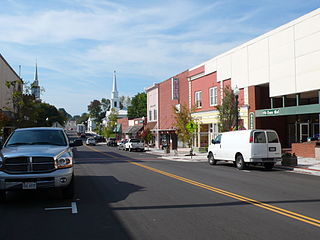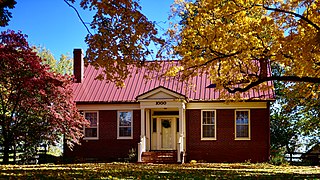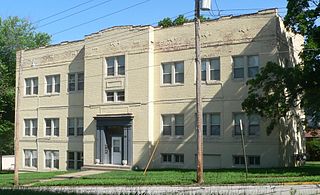
Boonville station is a historic train station located at Boonville, Cooper County, Missouri. It was built in 1912 by the Missouri–Kansas–Texas Railroad. It is a one-story, nine bay, Mission Revival-Spanish Colonial Revival style building sheathed in stucco. A projecting bay which houses a telegrapher's station and the patrons' and trainmen's lobby. It features stepped and arched brick parapets at each gable end supported by three arched columns.

St. Matthew's Chapel A.M.E. Church is a historic African Methodist Episcopal church located at 309 Spruce Street in Boonville, Cooper County, Missouri. It was built in 1892, and is a one-story, rectangular, gable roofed Gothic Revival style brick church. It has a hipped roof three story projecting tower and a rectangular, hipped roof, brick apse attached to the rear.

Christiansburg Downtown Historic District is a national historic district located at Christiansburg, Montgomery County, Virginia. The district encompasses 32 contributing buildings, 1 contributing site, and 2 contributing objects in the central business district of Christiansburg. The district includes a variety of one-, two-, or three-story commercial or office buildings built primarily from the 1915-1950 period. The courthouse square is the cultural and historic center of the district. Notable buildings include the Taylor Office Building, Bank of Christiansburg (1963), Dr. George Anderson House, Zirkle Building (1910), Cromer Furniture Building, Presbyterian Manse (1876), Barnes-Surface Motor Co., Virginia Inn Hotel, and Leggett's Department Store (1958). The contributing objects are the Confederate Memorial (1883) and War Memorial (1953). Located in the district and separately listed are Christiansburg Presbyterian Church, U.S. Post Office, and Phlegar Building.

Capitol Avenue Historic District is a national historic district located at Jefferson City, Cole County, Missouri. It encompasses 107 contributing buildings in a predominantly residential section of Jefferson City. The district developed between about 1870 and 1947, and includes representative examples of Classical Revival, Late Victorian, Bungalow / American Craftsman, and Art Deco style architecture. Located in the district are the separately listed Lester S. and Missouri "Zue" Gordon Parker House, Jefferson Female Seminary, Missouri State Penitentiary Warden's House, and Ivy Terrace. Other notable buildings include the Parsons House (1830), former Missouri Baptist Building (1947), Grace Episcopal Church (1898), Elizabeth Alien Ewing House (1873), James A. Houchin House, J. Henry Asel, Sr. and Hilda Asel House (1898), Dix Apartments (1915), W.C. Young House, Bella Vista Apartments (1928), and Prince Edward Apartments (1930).

Albert Gallatin Blakey House is a historic home located at Boonville, Cooper County, Missouri. It was built about 1900, and is a 2+1⁄2-story, Queen Anne style brick dwelling. It has a two-story, rectangular brick addition with flat, parapeted roof and a two-story frame porch added about 1910.

Morton–Myer House is a historic home located at Boonville, Cooper County, Missouri. It was built about 1859 and enlarged about 1870, and is a 1+1⁄2-story, vernacular brick dwelling with a central hall plan. It has a rear ell and rear shed additions and partial basement. Also on the property are the contributing brick smokehouse and stone cellar.
Meierhoffer House is a historic home located at Boonville, Cooper County, Missouri. It was built about 1900, and is a one-story, vernacular brick dwelling with a central hall plan. It has a gable roof, arched window and door headers, and partially expose basement.

Sumner Public School, also known as the Daniel Boone Apartments, is a historic school building located at Boonville, Cooper County, Missouri. It was built in 1915, and is a two-story, rectangular brick structure with a central projecting bay. The roof is framed by a stepped, corbelled parapet on the front facade. The school served as an African-American public school until converted into apartments in 1939–1940.

Hamilton-Brown Shoe Company Building, now the Selwyn Place Apartments, is a historic factory building located at Boonville, Cooper County, Missouri. It was built in 1919 by the Hamilton-Brown Shoe Company, and is a four-story, rectangular brick industrial building with a flat roof. The roof is framed by a corbelled parapet capped with tile coping. The building features a five-story elevator tower and four-story tower which housed restrooms. Also on the property are the contributing power plant building and oil house.

Meierhoffer Sand Company Office Building was a historic office building located at Boonville, Cooper County, Missouri. It was built about 1900, and was a one-story, rectangular vernacular brick building with a gable roof. An addition was constructed about 1910 which housed a wagon scale. By 1929, the building was used as a grocery store and was later converted to a dwelling. It has apparently been demolished.

Cobblestone Street, also known as Fifth Street and Main Street, is a historic cobblestone street located at Boonville, Cooper County, Missouri. It was built about 1832, and was part of the original Fifth or Main Street. It is located beneath the Boonville Road Bridge and is constructed of cobblestones of varying sizes. The street remnant is approximately 20 feet wide and approximately 200 feet long. The street connected the main commercial district of Boonville with the wharves along the Missouri River.
Historic District A is a national historic district located at Boonville, Cooper County, Missouri. It encompasses 15 contributing buildings associated directly or indirectly with the Kemper Military School and College. The district includes the Kemper Administration Complex (1842-1904), "A" Barracks (1909), "D" Barracks (1916-1918), Johnston Field House and Pool Annex (1923-1925), Math Hall (1905-1906), Lamar Residence (1858-1860), Darby Residence (1858-1860), Dillender Residence (1895), Bertha Hitch Hall, and Kusgen-Melkersman Residence (1890-1910).
Historic District B is a national historic district located at Boonville, Cooper County, Missouri. It encompasses 23 contributing buildings in a predominantly residential section of Boonville. The district includes representative examples of Late Victorian style architecture. Notable buildings include the Dukes Residence (1900-1910), Windsor Residence, Hofstedler Residence (1920-1925), Short Residence (1908), Hain Residence (1836-1840), Hickam Estate Property (1840s), Christ Church Episcopal (1844-1846), and Christ Church Episcopal.
Historic District C is a national historic district located at Boonville, Cooper County, Missouri. It encompasses 63 contributing buildings in a predominantly residential section of Boonville. The district includes representative examples of Greek Revival and Queen Anne style architecture. Notable buildings include the Childers, Sr., Residence (1892-1900), Schmidt Residence (1915), Moore Residence (1880s), Holmes Property (1829-1843), Holmes Property (1829-1840), Patterson Residence (1869), Boonville Daily News Property (1910-1917), Higbee Residence (1911-1917), Knabe Rental Property (pre-1849), Catlett Property (1839), Bittner Residence (1900-1910), Putnam/Wiehe Residence (1836-1839), Cooper Residence (1860s), Travis Property (1850s-1860s), and Zoeller Property.
Historic District E is a national historic district located at Boonville, Cooper County, Missouri. It encompasses 88 contributing buildings in a predominantly residential section of Boonville. The district includes representative examples of Late Victorian style architecture. Notable buildings include the Dyer Residence (1870), Burns Residence, Rennison Residence (1890s), Lauer Residence (1830-1833), Robinson Residence (1905), Bell Residence (1886), Schuster Residence (1833), Kempf Residence (1890s), Cooper County Court Property, Morgan Street Baptist Church (1884), Waible Residence (1833-1848), and United Church of Christ.
Historic District F is a national historic district located at Boonville, Cooper County, Missouri. It encompasses 40 contributing buildings in a predominantly residential section of Boonville. The district includes representative examples of Greek Revival and Late Victorian style architecture. Notable buildings include the Gann-Ruddell Residence, Weed Residence (1897), Weed Residence (1860s-1870s), Embry Residence (1853), Foursquare Gospel Church, Heyssel Residence (1860s), Hayes Residence (1892-1900), Earhart Residence (1899), Maplewood Apartment (1892), and Smith/Whitehurse Residence (1850s-1860s).
Historic District H, also known as the Missouri Training School for Boys District, is a national historic district located at Boonville, Cooper County, Missouri. It encompasses 15 contributing buildings associated with the Missouri Training School for Boys, a state juvenile detention facility. The district includes representative examples of Late Victorian style architecture. Notable buildings include the Administration Building (1890), Superintendent's Residence (1910-1917), Dining Hall (1890s), Commissary (1910-1917), and Barn.
Commercial Community Historic District is a national historic district located at Lexington, Lafayette County, Missouri. The district encompasses 106 contributing buildings and 1 contributing structure in the central business district and surrounding residential area of Lexington. It developed between about 1830 and 1930, and includes representative examples of Late Victorian and Gothic Revival style architecture. Located in the district is the separately listed Lafayette County Courthouse. Other notable buildings include the Lexington Racquetball Club, Missouri Public Service Storage Building, Franklin Diner, Wright House, Goehner's Marbleworks, First Presbyterian Church, Municipal Auditorium (1930), Leiter Apartments, Lafayette County Sheriff's Office and Jail (1939), Morrison Wentworth Bank Building, and Winkler Theatre.
Bonnots Mill Historic District is a national historic district located at Bonnots Mill, Osage County, Missouri. It encompasses 98 contributing buildings in the central business district and surrounding residential sections of Bonnots Mill. The district developed between about 1840 and 1942, and includes representative examples of Bungalow / American Craftsman and I-house architecture. Located in the district is the separately listed Dauphine Hotel. Other notable buildings include the Bonnots Mill School (1889), Henry Dieckriede House, Bonnots Mill United Methodist Church (1915), Bank of Bonnots Mill (1907), Bonnet's Mill Hotel / Krautman's Store, Meyer-Morfeld Milling Company, United States Post Office, St. Louis Parish Church and Rectory (1907), and St. Louis Parish School.

The Sedalia Commercial Historic District is a national historic district located at Sedalia, Pettis County, Missouri. It encompasses 102 contributing buildings in the central business district of Sedalia. The district developed between about 1870 and 1959, and includes representative examples of Italianate, Romanesque Revival, and Art Deco architecture. Located in the district are the separately listed Hotel Bothwell, Building at 217 West Main Street, and Missouri/Sedalia Trust Company. Other notable buildings include the First United Methodist Church (1888-1891), Pettis County Courthouse (1924), Anheuser Busch Bottling Works, the New Lona Theater (1920), Citizens National Bank Building, Third National Bank (1929), Federal Building (1930), Montgomery Ward Building (1936), the Uptown Theatre (1936), Missouri Pacific Depot, and Central Presbyterian Church.















